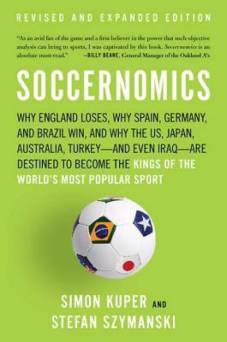
With the football World Cup final a couple of hours away, it’s only fitting that I write this post now. I began this book just as the World Cup was starting, and finished it a couple of hours ago, so it’s been a companion of my World Cup journey, so to say.
The book is framed around questions which every soccer fan (and non-fan) has asked over the years: Is England always destined to lose? How much does money matter in a club’s performance? How random are penalty shootouts? The answers given to these questions are based on crunching a mound of data across different types of matches – World Cup, country Leagues, Euro etc, and the answers – not really (they’ll win once in 50-odd years), a lot and not much if you analyze players’ past performances – are sometimes surprising and sometimes not. The authors make the argument that some of the great myths of football can be broken if you Moneyball the game, and they apply statistics to answer questions about clubs, fans, countries etc.
While I enjoyed reading the book, I must say that the answers to the main questions did not add much to my overall knowledge base. It’s quite obvious that black players were discriminated against (in selection and in salaries) for a long time, just as they would have been in other spheres of life; of course higher player salaries have a strong positive effect on club performance. What I found more interesting were the small tidbits that came in the process of answering those questions: Croatia has the highest TV viewership of soccer (advertisers who read this book stand to make a lot of money in today’s final); Norway is the most soccer-crazy country (based on playing, live watching and TV viewing statistics); how well a club takes care of its players off the field (relocation assistance particularly) matters more than how much it pays them. Also, knowing a bit of math and statistics, their analysis and conclusions often seemed to be a bit of overreach, but I’m willing to discount that due to quality (or lack) of data. My other peeve was the enormous focus on EPL; even the Champions League was barely spoken about, and non-European leagues didn’t even get a mention. I believe that as the book touting to bring economic scholarship to all aspects of the great game, I believe they could have done with a bit more inclusivity and rigor.